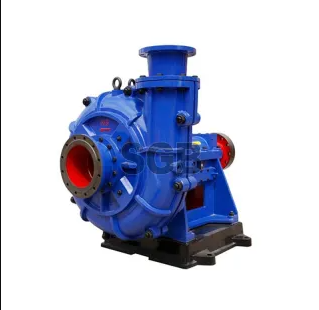The Differences Between Slurry Pump and Centrifugal Pump
Pumps play a crucial role in various industries, such as mining, chemical processing, and wastewater treatment. They are used to transfer fluids from one place to another, and they come in different types and designs, depending on their application. Two common types of pumps are the slurry pump and the centrifugal pump. While both pumps are used to move fluids, they differ in their design, construction, and operation. In this essay, we will explore the differences between these two pumps and their respective applications.

A centrifugal pump is a type of pump that uses a rotating impeller to move fluids. The impeller creates a centrifugal force that pushes the fluid outwards from the center of the impeller, towards the pump casing. As the fluid flows through the casing, it gains momentum and pressure, and it is eventually discharged through the pump's outlet. Centrifugal pumps are commonly used in applications where high flow rates and low to moderate head pressures are required. They are ideal for transferring clean or slightly abrasive fluids such as water, chemicals, and petroleum products.
On the other hand, a slurry pump is designed to handle fluids that contain high solids content, such as mud, sludge, or sand. These fluids are highly abrasive and corrosive, and they can cause severe damage to standard centrifugal pumps. Slurry pumps are designed to handle such fluids by using a special impeller and casing that are highly wear-resistant. The impeller has vanes that are wider and more robust than those of a centrifugal pump, and the casing is made of hardened materials such as cast iron or high-chrome steel. Slurry pumps also have a unique seal design that prevents the fluid from leaking into the pump's bearings and motor.
Another significant difference between the two pumps is their energy consumption. A slurry pump requires more power to operate than a centrifugal pump due to the higher density and viscosity of the fluid it handles. The slurry pump's impeller also has a larger diameter and a lower rotational speed than a centrifugal pump's impeller, which results in higher energy consumption. Moreover, the slurry pump's casing has a larger cross-sectional area to accommodate the large particles in the fluid, which further increases its power consumption.
In terms of maintenance, slurry pumps require more frequent and more extensive maintenance than centrifugal pumps. The abrasive and corrosive nature of the fluids they handle causes wear and tear on the impeller and casing, which must be replaced periodically. The seals and bearings of a slurry pump also require frequent lubrication and replacement. Centrifugal pumps, on the other hand, require minimal maintenance and can operate for long periods without significant wear.
In conclusion, while both slurry pumps and centrifugal pumps are used to move fluids, they differ significantly in their design, construction, and operation. Centrifugal pumps are ideal for clean or slightly abrasive fluids with low to moderate head pressures, while slurry pumps are designed to handle highly abrasive and corrosive fluids with high solids content. Slurry pumps require more power to operate and more frequent maintenance than centrifugal pumps, making them more costly to operate. Understanding the differences between these two pumps is essential to choosing the right pump for a particular application, which can improve efficiency, reduce downtime, and save costs.
Comments
Post a Comment